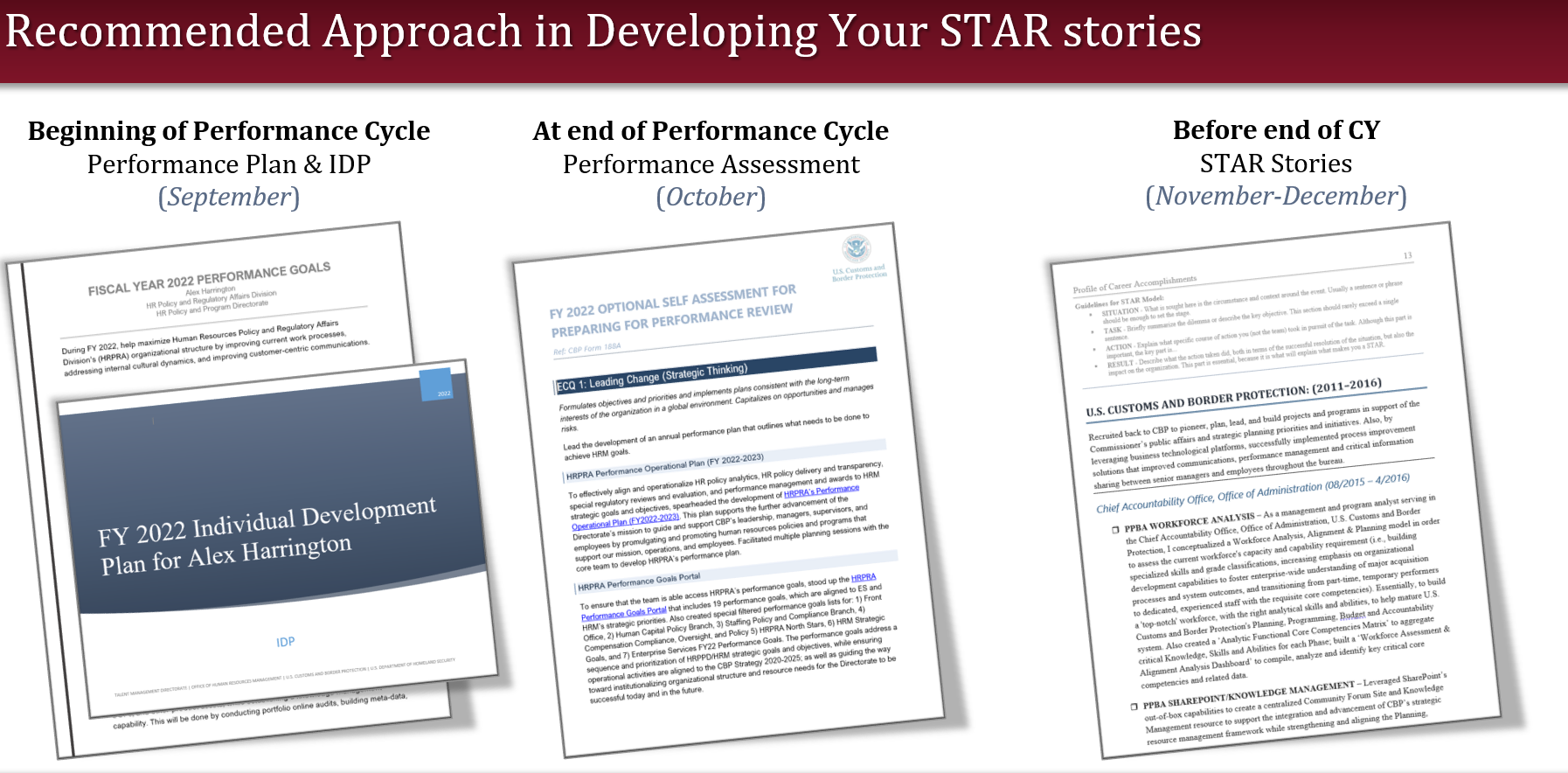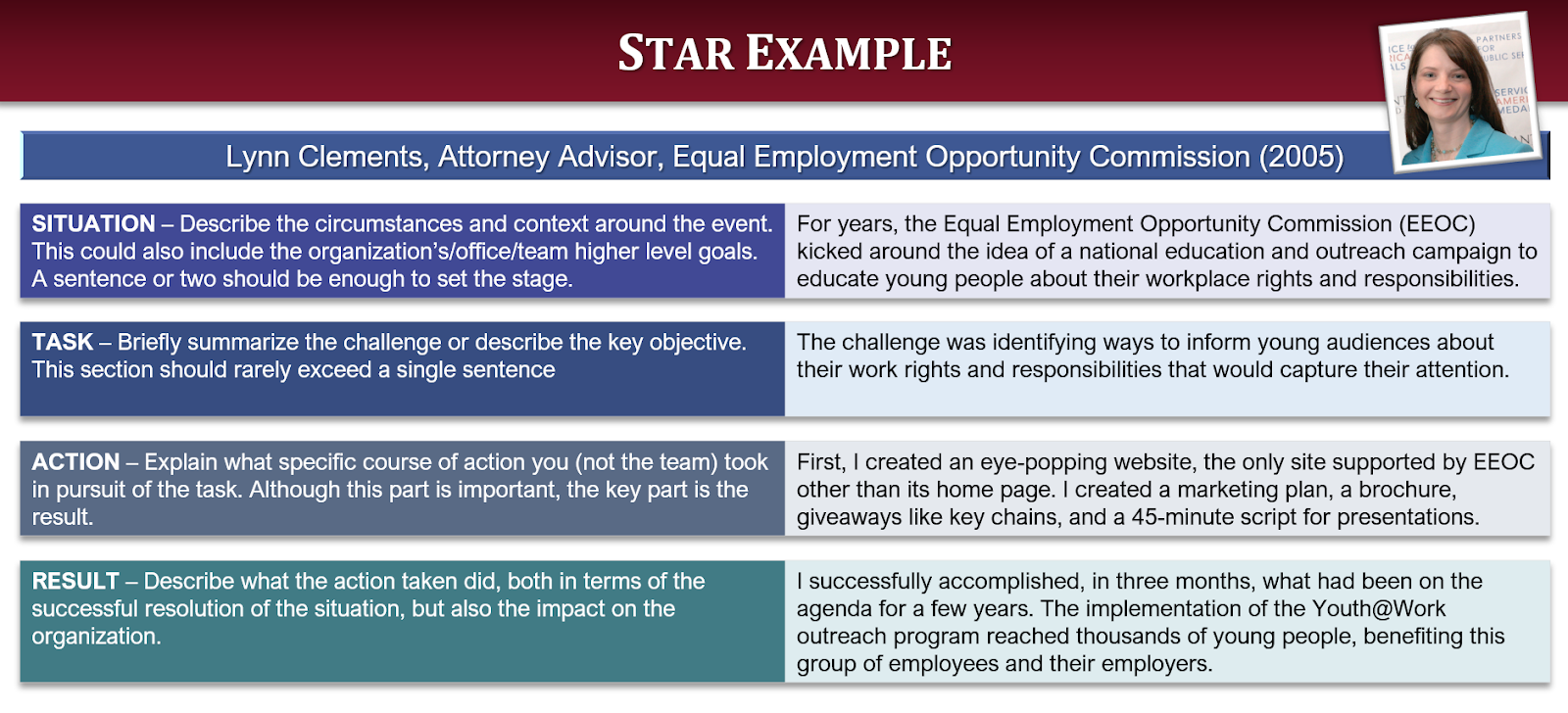SHINE BRIGHT IN YOUR NEXT INTERVIEW: KEEP YOUR STAR STORIES READY FOR EVERY OPPORTUNITY

By Alex Harrington, GCDF, CCSP
Editorial Note: This blog is part of a series written for fellow federal employees who, like me, are facing the challenge of moving on after a career in public service. After nearly 30 years—serving first in the U.S. Marine Corps and then as a federal civil servant—I’ve found myself among those impacted by the current Administration’s workforce reductions. Accepting the Department of Homeland Security’s early retirement offer was not an easy decision, but it has placed me on a new path. One that I know many of you are walking as well. My goal in this series is to share practical tools, strategies, and encouragement drawn from both my professional credentials and my own transition journey, with ChatGPT helping me refine and organize these ideas so they’re ready to support you in your next chapter.
______________________________________________________________________________________________________
Why STAR Stories Are Your Interview Superpower
Interviews—especially during a career pivot—are not about reciting your résumé or giving your entire career anthology. They’re about telling evidence-based stories that show you can solve problems, take initiative, and deliver results. That’s where the STAR method comes in.
If you are a displaced federal employee—or considering early retirement—you may already be familiar with the CCAR format (Challenge, Context, Action, Result). This method is often used by federal job candidates aspiring to the Senior Executive Service (SES), as well as in federal résumés and interviews. In the private sector, however, a similar approach called the STAR format is more commonly used:
- Situation – The background and context of the challenge.
- Task – The goal you needed to accomplish.
- Action – The specific steps you took.
- Result – The outcome and the impact of your actions.
💡Pro Tip: A significant benefit of using the STAR format is that it helps you answer behavioral-based questions—i.e., “Tell me about a time when…”—with confidence and clarity.
The Danger of Waiting Until You Need Them
As a career coach, one of the first questions I ask job seekers is, “Do you keep a living document of your significant accomplishments?” Unfortunately—and often to my surprise—the answer is usually no. Too often, people wait until they’re actively job hunting to start compiling their STAR stories. By then, key details have faded, metrics are unclear, and the impact of those hard-earned accomplishments is diminished.
If you’re a displaced federal employee—or even just considering a career change—the best time to start is now. Start keeping an ongoing record of your STAR stories now, and you’ll always have fresh, detailed examples ready to tailor for any opportunity.
Start keeping an ongoing record of your STAR stories now, and you’ll always have fresh, detailed examples ready to tailor for any opportunity.
Why Keep a Living STAR Document
Think of your STAR document as your career toolbox—or a personal swipe file of professional wins. It’s more than a list of accomplishments; it’s a ready-to-use resource you can pull from for:
- Interview prep–Confidently answer behavioral questions.
- Résumé customization–Match stories to job requirements.
- Networking–Share concise, compelling examples of your work.
- Cover letters–Illustrate your value with evidence.
How to Build and Maintain It
Choose Your Format. Decide where you’ll keep your STAR stories so they’re easy to update and retrieve. The following are recommended options:
- Word or Google Docs–Best for narrative detail.
- Excel or Google Sheets–Ideal for sorting, filtering, and tagging by skill or role.
- Cloud-based notes apps (e.g., Evernote, Notion, or Microsoft OneNote) – Great for quick updates on the go and cross-device access.
💡Pro tip: Choose a format you’ll actually use consistently. If you already track projects in Excel, a spreadsheet might be the easiest choice.
Use a Standard Template. A consistent structure makes your stories easier to scan and adapt. Your template should have these fields:
- Situation–Brief context and background.
- Task–The challenge or objective.
- Action–The specific steps you took.
- Result–The outcome and organizational impact.
- Metrics–Quantifiable results (numbers, percentages, time saved).
Update Your STAR Stories Regularly. Don’t wait until you’re job hunting to record achievements—by then, you’ll forget important details.
- Set a quarterly reminder to add new STARs.
- Include both big wins and smaller, everyday successes that demonstrate valuable skills.
- Update metrics while they’re still fresh (e.g., exact revenue growth, cost savings, or efficiency gains).
💡 Pro Tip: If you’re currently employed, align your STAR updates with your performance review prep—two birds, one stone. Each year, I built my performance plan with clear objectives, then used it as a reference to develop new STAR stories at the year’s end (see example below).

Tag by Skill. Label each STAR story with relevant skills or competencies so you can pull the right examples fast.
- Common tags: Leadership, Process Improvement, Customer Service, Technical Troubleshooting, Collaboration, Project Management.
- If you’re targeting a new industry, also tag for transferable skills (e.g., “Stakeholder Engagement” instead of “Agency Liaison”).
Quantify Results. Numbers make your stories credible and compelling. Where possible, include:
- Percentages–“Increased customer satisfaction scores by 18%.”
- Dollar amounts–“Saved $250,000 annually through process improvements.”
- Time savings–“Reduced onboarding time from 10 days to 3 days.”
- Volume–“Trained 500+ employees across three divisions.”
Final Thought
Building and maintaining a living STAR repository isn’t just a job search exercise—it’s a career habit that will serve you for years to come. Whether you’re preparing for your next interview, updating your résumé, or simply reflecting on your growth, having your accomplishments documented keeps you confident, credible, and ready when opportunity arises. Don’t wait until you need these stories to start collecting them. Begin today! And you’ll be walking into every conversation—not just interviews—ready to shine.
Building and maintaining a living STAR repository isn’t just a job search exercise—it’s a career habit that will serve you for years to come.
Call to Actions:
______________________________________________________________________________________________________
Your Action Step for This Week
Be sure to block 60 to 120 minutes in your calendar. Write down three to six STAR stories from your most recent role—while details are still fresh. Don’t aim for perfection; aim for accuracy and completeness. And be sure to use your most recent performance reviews, awards, feedback from your supervisor, to help jog your memory in the brainstorming phase. This effort will prepare you for your next interview. So, when your next interview comes a knock’n…you won’t be scrambling to remember the details—you’ll walk in ready to shine!
Further Reading
How To Use the STAR Interview Response Technique (6/9/2025)
How do you structure your STAR stories to make them clear, concise, and impactful? (4/7/2025)
STAR Method: How to Use This Technique to Ace Your Next Job Interview (5/14/2024)
Use the STAR Method in Your Next Job Interview
STAR Example
Partnership For Public Service’s Samuel J. Heyman Service to America Medals. The award write-ups for the Honorees serve as great examples for your STAR Stories. I took one Honoree’s award write-up and organized it by the STAR Format: Lynn Clement (2005 Emerging Leader)

______________________________________________________________________________________________________
About the Author:
Alex Harrington, GCDF, CCSP, is retiring after nearly three decades of distinguished federal service, most recently as Senior Executive Advisor for Policy and Performance Operations with the U.S. Department of Homeland Security. A Certified Career Services Provider and Global Career Development Facilitator, Alex founded Federal Career Connection, an initiative that has helped thousands navigate career transitions into public, national, and military service. A Persian Gulf War veteran and former U.S. Marine, he writes about resilience, leadership, and hope, drawing deeply from his personal journey as a Stage IV cancer fighter. Alex resides in West Virginia with his wife, Teresa.


